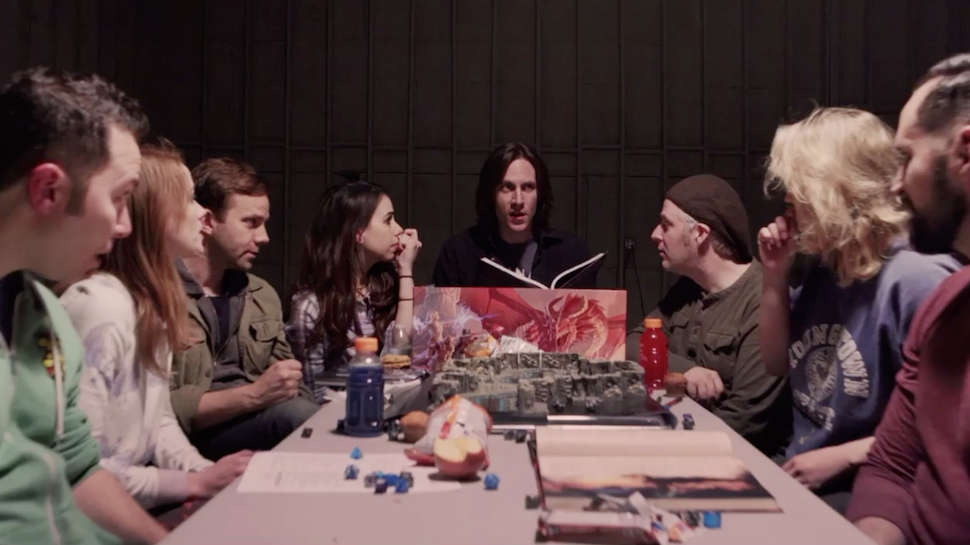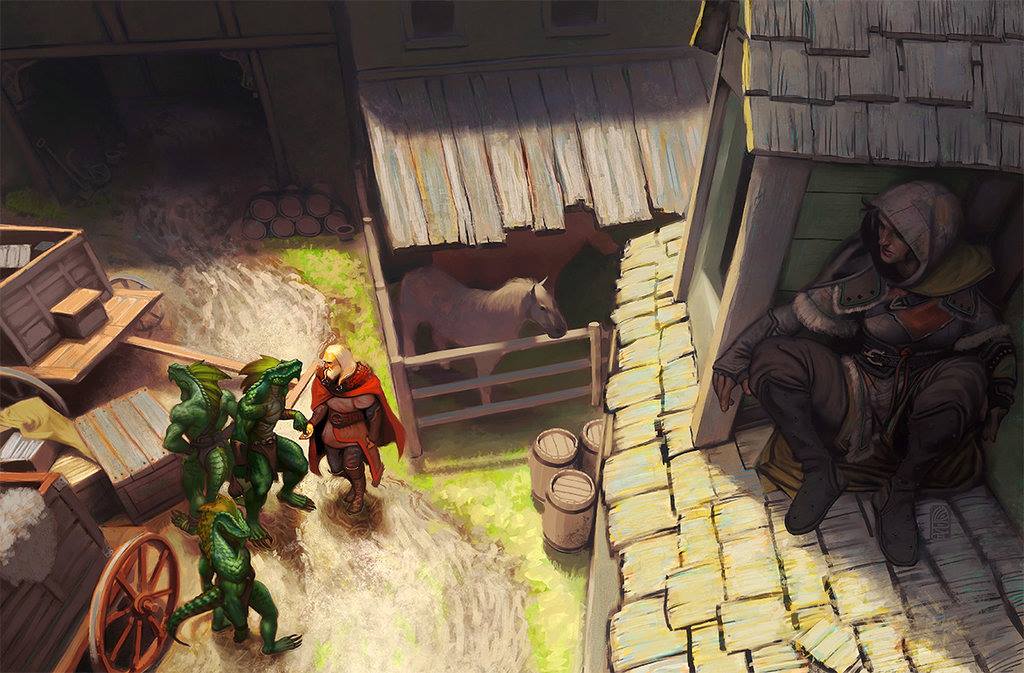An Introduction to Tabletop Roleplaying-Games
By Jesse Grote
Three bold adventurers are exploring an ancient watchtower. They sneak up a crumbling stairway and through a dusty corridor, careful not to trip over the debris and loose pebbles that litter the floor. The first room they pass is empty. The second is blocked by a wooden door; worn but still sturdy, and locked to boot. A trembling voice sounds from the other side, “I know you’re there. I warn you, there’ll be trouble if you dare come in here!” Two of the adventurers try to reason with the man, while the third – a dwarf – goes back to investigate the room they just passed. She feels a draft coming from under one of the walls. A seam! She runs her dagger along the groove until she finds a locking mechanism, and opens a hidden door in the wall with a soft ‘click.’ The dwarf carefully makes her way through the newly discovered secret passage. Her fellow adventurers hear the man on the other side of the door cry out in surprise. A weapon is drawn, and then dropped to the ground with the clatter of steel on stone. Moments later, the door opens, and the adventurers see their grinning companion standing in the door opening.
While you keep that story in the back of your mind, let me tell you that it isn’t as strictly fictitious as you might believe. This story has not, like many of its kind, sprung from the mind of one author for the purpose of being put onto a page. Instead, what you just read was a memory of an interaction between four people, one of which was yours truly. It happened while we were playing a game – a roleplaying-game (RPG), to be precise. It’s possible that you’ve heard that term before, as UCR has quite a lively community built around such games, but RPGs have never been the most transparent hobby. Well, if you’ve got an interest in what RPGs are, and how they’re played, I’d be happy to be your X-ray.

There are many different kinds of roleplaying-games, but what they all share in common is a central focus on cooperative storytelling; they see all the players create a story together. The kind of story being told varies from group to group, and the way in which the story is built depends on the kind of RPG being played. Since Dungeons and Dragons is widely regarded to be the best-known RPG, and serves as the inspiration for many other games, we’ll use some examples specific to that game. In general, a game is played with 4-6 players, although deviations on either side are not impossible.
All but one player portray a single character in the narrative. They have a character-sheet describing their strengths, weaknesses, and personality, and they decide their character’s actions within the story. Sometimes, this looks like they are sitting by a campfire and telling a story, and other times it comes closer to acting out their character as one might do in improv theatre. The final player is called the ‘game master.’ They portray all characters not played by the players (villains, villagers, etc.), and describe the setting in which the story unfolds. Let’s take a look at the example above: the game master describes an old and dilapidated watchtower. The players describe how their characters sneak inside, and maybe play out how two of them tell the third to be quiet when he nearly trips over a pebble. The game master presents an obstacle, a locked door. They play the character behind the door, and ask the players how they wish to try and solve the problem.
Earlier, I compared roleplaying-games to other creative exercises, such as improv theatre and fireside storytelling. While the two do indeed share similarities, there is a key difference in the fact that RPGs have clearly defined rules according to which the action unfolds. This is what makes them a game. Most of these rules govern what the players’ characters can and can’t do, and how to determine whether they succeed in the undertakings they attempt. In our example, the game master asked the player portraying the dwarf to roll a die when she tried to find the secret passage. The result of the die had to be a certain number or higher for her to succeed. If she hadn’t rolled high enough, she might’ve failed to notice the hidden door, and the adventurers would’ve had to seek a different way forward. Perhaps the other two adventurers could’ve broken down the wooden door, or persuaded the man of their good intentions. Both would’ve required a die roll as well. Each character has their strengths and weaknesses. This is reflected in the rules by making it easier to roll the required number for a task that the character is good at than for one they’re less skilled in. Perhaps our dwarven friend was well learned on the subject of architecture, allowing her to infer that there was something strange about the wall holding the secret door.
Like many hobbies, RPGs have a wide variety of aspects that make them attractive – different people play them for different reasons. In speaking with fellow players, however, I have found two arguments that are often cited as reasons for their interest in the hobby. The first of these is the platform for creative expression that RPGs offer; many people enjoy creating a character, acting out their personality, and thinking of solutions to obstacles from their character’s perspective. That last point is where the importance of the game’s rules becomes clear. They provide the setting with a consistent framework that lends a sense of real-ness and weight to the players’ actions. If all the adventurers in our example could simply turn into a ghost and walk through the door without any chance of failure, there would barely be any creative element to solving the problem, nor would the achievement have any narrative payoff. The second reason many people seem to like RPGs is the bonds of friendship the activity builds. Personally, I’ve met many of my friends at UCR through Dungeons and Dragons, and playing the game is our most frequent activity whenever we meet up. It has been suggested that the emotional effects of imaginary events in a narrative are very similar to those of events in the real world, so players of an RPG often feel like they’ve actually gone on an epic journey together after finishing a game. I’d say that’s a pretty good way to make friends.
We’ve reached the end of our quest today, but if the thirst for knowledge still fills you, there’s plenty more to explore. Nowadays, RPGs are becoming increasingly visible in ‘mainstream’ society as their developers push for more transparency and exposure. If you’d like to see what a game of Dungeons and Dragons is like, make sure to search for the show Critical Role on YouTube or Twitch. For more in-depth discourse about the mechanics of RPGs and their role in our lives, I recommend you start by checking out game designer Matt Colville’s YouTube channel and the online blog The Alexandrian. May your feet carry you on a good path.
Jesse Grote, Class of 2018, is a Philosophy and Practical Art major from Middelburg, the Netherlands.

